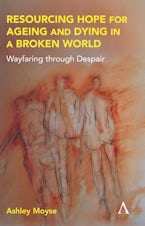- Home
- Sophia Studies in Cross-cultural Philosophy of Traditions and Cultures
- philosophy
- religion
- Ethics without Self, Dharma without Atman

Ethics without Self, Dharma without Atman
Western and Buddhist Philosophical Traditions in Dialogue
By: Gordon F. Davis
Series: Sophia Studies in Cross-cultural Philosophy of Traditions and Cultures
284 Pages
- Hardcover
- ISBN: 9783319674063
- Published By: Palgrave MacMillan
- Published: July 2018
$109.00
Cross-cultural comparative philosophy is a burgeoning area of contemporary research; there are signs, too, that as the research increases in scope and rigor, the appetite for more of it in university courses is growing. One of the most fruitful areas of such research has been the interface between certain strands of Western philosophy (notably ethics and phenomenology) on the one hand and elements of Buddhist philosophy (including themes from Abhidharma, Madhyamaka, and Yogācāra) on the other. Ethics without Self, Dharma without Atman: Western and Buddhist Philosophical Traditions in Dialogue makes an important contribution to that literature, with a specific focus on the relation between ethics and the metaphysics of selfhood across a range of philosophies.
Comprising thirteen chapters, most of which are fewer than twenty pages in length, the book provides digestible treatments of the topics concerned. The principal exception is chapter 2 (Michael Griffin), which is a fifty-three-page study of “The Ethics of Self-Knowledge in Platonic and Buddhist Philosophy,” including a seven-page appendix on Aristotle. Despite the thoroughness of its comparative analysis, this chapter could have benefited from a clearer exposition of its methodology and purpose: is it intended to show merely that similarities and differences exist between Platonic, Aristotelian, and Buddhist thought, or is Griffin seeking to do more than that—to illuminate aspects of those traditions which would not otherwise come to light?
The book is coherently structured, displaying a roughly historical trajectory. Davis’s opening chapter introduces central themes, identifies key philosophers, and summarizes the book’s subsequent chapters, bringing out their interconnections. Davis distinguishes between two main phases in the history of Western philosophy’s encounter with Buddhism, namely “pre-contact” and “post-contact.” The first of these is the phase in which Western philosophers had heard about Buddhist (and other Asian) ideas but did not yet have access to primary sources. The “post-contact” phase is that which begins towards the end of the 18th century, when philosophers such as Schelling, Schopenhauer, and Schleiermacher began to work directly with primary texts, albeit in translated editions. As Davis remarks, both in the introduction and in the final paragraph of chapter 13 (co-authored with Pragati Sahni), the current phase of cross-cultural philosophy is one in which an expanding group of philosophers from both Western and Asian countries are building upon and going beyond the efforts of their forebears; they are doing so by engaging with philosophical sources from several traditions in, to a large extent, the original languages.
Most of the chapters bring Buddhist ideas into dialogue with one or two Western philosophers, the majority of whom are major historical personages, such as Plato, Aristotle, various Stoics, Sextus Empiricus, Spinoza, Hume, Kant, Schopenhauer, Nietzsche, Heidegger, William James, and Bertrand Russell. The final three chapters discuss more recent Western philosophers, namely Derek Parfit, Charles Taylor, and (chap. 13) the philosophy of deep ecology associated with Arne Naess and Joanna Macy. On the Buddhist side, the most frequently recurring name is that of Śāntideva, well known for his masterwork the Bodhicaryāvatāra (“Guide to the Bodhisattva’s Way of Life”). References are also made to the Milindapañha (“Questions of King Milinda”), an ancient text in which the monk Nāgasena draws an analogy between a human being and a chariot to illustrate that both are analyzable into component factors without the need for any factor to be treated as an ultimate essence. Other notables referred to include the Tibetan teachers Tsongkhapa and Patrul Rinpoche (chap. 3), Nāgārjuna and other Mādhyamikas (principally in chapters 4 and 6), advocates of the theory of consciousness known as vijñānavāda (chap. 8), and more recent Buddhist exponents such as Thich Naht Hanh and the Dalai Lama (both quoted at some length in chap. 12). The gamut of voices cited within the volume is therefore plentiful, generating stimulating cross-cultural conversations.
The volume’s comparative exercises are, for the most part, successful in exposing both resemblances and contrasts between the philosophical positions under examination, thereby disclosing possibilities that may have remained concealed if the inquiry had been more culturally and historically constrained. Especially instructive are the discussions of different conceptions of detachment in chapters 3 and 9, by Emily McRae and Sonia Sikka respectively. Comparing Stoic notions of apatheia and ataraxia with Tibetan Buddhist notions of detachment, McRae emphasizes the extent to which the latter have a place for the cultivation of “positive emotionality, particularly love, compassion, and sympathetic joy” that tends to be absent from the Stoic models (82). Sikka, meanwhile, explores how Heidegger’s early sense of “resoluteness” came to be replaced in his later work by Gelassenheit, which is closer in meaning to “releasement,” “letting go,” or “serenity.” By comparing these notions both with Buddhist understandings of detachment and, more briefly, with the theme of nonattachment to the fruits of one’s actions in the Brahmanical Bhagavad Gītā, Sikka exemplifies how a comparative approach can enhance an investigation of a subtle ethical-existential concept.
More puzzling is Stephen Harris’s argument (chap. 11) that Śāntideva provides a possible response to objections raised against Derek Parfit’s ethical theory. Citing Christine Korsgaard and Susan Wolf, Harris offers a lucid summary of the objection, which is that human experience has a depth that is achievable only insofar as we treat one another as “temporally extended beings,” as opposed to the succession of temporal parts to which humans are reduced both by Parfit and, on a certain interpretation, by many Buddhists (230). According to Harris, Śāntideva blocks this objection by highlighting “the unsatisfactory nature of human lives” (233), but it was unclear to me how this amounts to anything more than begging the question against Wolf and Korsgaard—and against anyone else who finds the richness of human life to be contrary to the unsatisfactoriness that Śāntideva perceives.
Regardless of any weaknesses that might be present in particular chapters or arguments, this volume as a whole constitutes a valuable addition to philosophical exchanges between Western and Buddhist traditions, competently exemplifying how these streams of intellectual endeavor can be brought into productive comparative, and occasionally critical, dialogue.
Mikel Burley is Associate Professor of Religion and Philosophy at the University of Leeds.
Mikel BurleyDate Of Review:November 12, 2018
Gordon F. Davis is Associate Professor of Philosophy at Carleton University.











